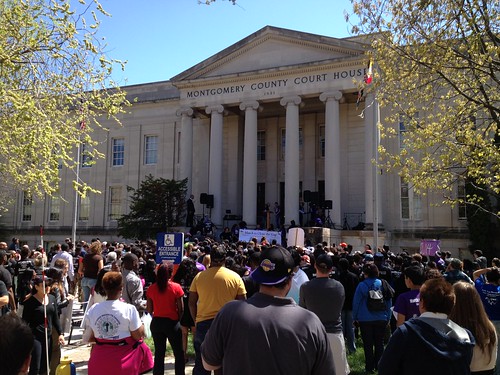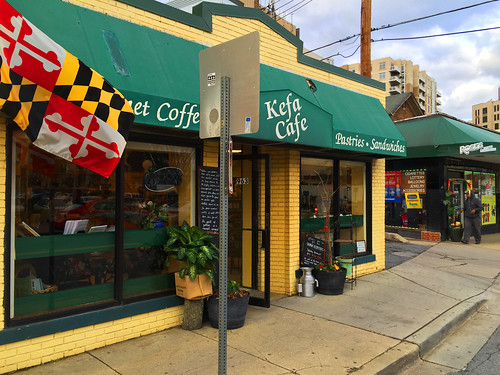Montgomery County school board elections are usually pretty sleepy. But as the county's once-vaunted schools struggle to serve a more diverse population, the "achievement gap" is causing this year's race to heat up.
 |
| Montgomery County students marched to protest the achievement gap, which is an election year issue. Photo by the author. |
Montgomery County Public Schools has grown rapidly in recent years, but has also become
more segregated by race and class. Student performance is slipping, particularly in schools with a concentration of minority and low-income students. School officials have
been reluctant to address the problem or even admit that it exists.
Schools make up half of the county's $5 billion annual budget, and the teachers' union's coveted "Apple Ballot" endorsements have had a big influence on local elections. But that's changed as the school system's performance has slipped. Jill Ortman-Fouse won a seat on the board in 2014 after campaigning to reform the system; three months later,
superintendent Josh Starr resigned when he realized a majority of the board no longer supported renewing his contract.
Meet the candidates
There are three open seats this year, but two of them have two candidates, who will both go on to the general election in November. But a three-way race has formed for the at-large seat between incumbent Phil Kauffman, retired principal Jeanette Dixon, and former teacher and student board member Sebastian Johnson. One Montgomery, the school equity group I helped start, interviewed all three. (Full disclosure: we've endorsed Johnson.)
Kauffman lives in Olney and was a PTA activist before joining the board in 2008. His wife teaches at Blake High School, which both of his daughters also graduated from (full disclosure: I was friends with them in high school).
He
ran as a reformer in 2008, calling for greater transparency in budget decisions and changes to the middle school curriculum. At the time, he said the school board was too cozy with the superintendent and needed to be more independent. Two terms later, he defended keeping Starr as superintendent, and as president of the board in 2014, he joined Starr in threatening to
cut programs for high-needs students if the school system didn't get a $15 million budget increase.
Dixon, who lives in East County, is familiar with the challenges facing the county's majority-minority, high-poverty schools. She was principal at Paint Branch High School (and before that, my principal at White Oak Middle School) before retiring three years ago.
Since then, she's been an outspoken critic of the school system and proponent of big ideas. At a League of Women Voters forum on the achievement gap last fall, she said that students should be allowed to attend any high school in the county, regardless of where they live.
In January 2015, she
published an open letter blasting Starr, calling him ineffective and saying he only cared about "protecting the MCPS brand." The letter may have helped turn public support away from him. (Inside sources say Starr has been quietly campaigning against her, calling her "dangerous" for the school system.) She's refused endorsements from elected officials, but has a long list of testimonials from faculty she's worked with and former students.
Johnson argues he can provide a new perspective to a board where members are often shut down for going against the grain. At 27, he's by far the youngest candidate, and describes himself as proof that schools can close the achievement gap. A former teacher and
student member of the board, he grew up in a single-parent household in Takoma Park before attending Georgetown, Harvard, and the London School of Economics.
He talks about the "intersectionality" of schools and factors outside the classroom, pointing out that students can't learn if their families can't afford health care or stable, decent housing. He wants more "wraparound services" like health centers at schools, while increasing minority student access to the county's largely segregated
magnet programs. He hopes his existing relationships with county councilmembers can smooth the
often adversarial relationship the board has with other county agencies.
Incumbent's supporters don't have much to say
While Kauffman and Dixon have long histories in the county, and Dixon may most reflect voters' frustration, it seems like Johnson has the most momentum. He's
raised over $20,000 (though his campaign stresses that most donations are small), an anomaly when most school board races are won for half that and incumbents barely raise money at all. He's gotten endorsements from several elected officials, including county councilmembers George Leventhal (who he once interned for) and Nancy Navarro (who he served with on the school board), and state delegate Marc Korman.
Kauffman's tried to pull support from his two black opponents by getting endorsements from black electeds like County Executive Ike Leggett, state delegate Al Carr, and county councilmember Craig Rice. But Rice has also publicly made glowing remarks about Johnson, saying, "We need more young people like Sebastian to step up and keep our county moving forward." Board of Education member Judy Docca, who also endorsed Kauffman, donated money to Johnson's campaign.
Normally, the Montgomery County Educators Association (the teachers' union) endorses the incumbent, almost guaranteeing their reelection. But they didn't
endorse Kauffman or anyone else, suggesting that the union's members are split.
That may reflect a broader disagreement about the school system.
Kauffman's supporters (like Starr's supporters) might argue that while things aren't perfect, the current leadership is doing a pretty good job. Dixon's and Johnson's supporters have a growing body of evidence to say that Montgomery County schools aren't doing enough to serve an increasingly diverse student body. If the 2014 election is a sign, this argument might be gaining ground.








